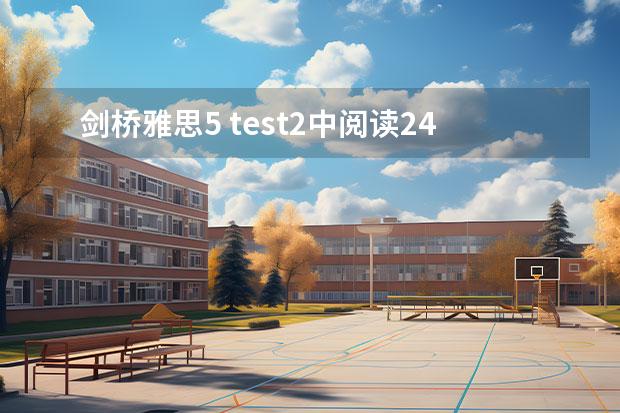剑桥雅思八test1阅读翻译 剑桥雅思阅读翻译相关内容,小编在这里做了整理,希望能对大家有所帮助,关于剑桥雅思八test1阅读翻译 剑桥雅思阅读翻译信息,一起来了解一下吧!
本文目录一览:

剑桥雅思阅读AUSTRALIA’SSPORTINGSUCCESS及答案解析
做好雅思的阅读题除了掌握对的 方法 ,也离不开我们日常的辛勤练习,下面我给大家带来剑桥雅思阅读AUSTRALIA’S SPORTING SUCCESS及答案解析,一起加油吧!
剑桥雅思阅读AUSTRALIA’S SPORTING SUCCESS
READING PASSAGE 1
You should spend about 20 minutes on Questions 1-13, which are based on Reading Passage 1 below.
AUSTRALIA’S SPORTING SUCCESS
A They play hard, they play often, and they play to win. Australian sports teams win more than their fair share of titles, demolishing rivals with seeming ease. How do they do it? A big part of the secret is an extensive and expensive network of sporting academies underpinned by science and medicine. At the Australian Institute of Sport (AIS), hundreds of youngsters and pros live and train under the eyes of coaches. Another body, the Australian Sports Commission (ASC), finances programmes of excellence in a total of 96 sports for thousands of sportsmen and women. Both provide intensive coaching, training facilities and nutritional advice.
B Inside the academies, science takes centre stage. The AIS employs more than 100 sports scientists and doctors, and collaborates with scores of others in universities and research centres. AIS scientists work across a number of sports, applying skills learned in one — such as building muscle strength in golfers — to others, such as swimming and squash. They are backed up by technicians who design instruments to collect data from athletes. They all focus on one aim: winning. ‘We can’t waste our time looking at ethereal scientific questions that don’t help the coach work with an athlete and improve performance,’ says Peter Fricker, chief of science at AIS.
C A lot of their work comes down to measurement — everything from the exact angle of a swimmer’s dive to the second-by-second power output of a cyclist. This data is used to wring improvements out of athletes. The focus is on individuals, tweaking performances to squeeze an extra hundredth of a second here, an extra millimetre there. No gain is too slight to bother with. It’s the tiny, gradual improvements that add up to world-beating results. To demonstrate how the system works, Bruce Mason at AIS shows off the prototype of a 3D analysis tool for studying swimmers. A wire-frame model of a champion swimmer slices through the water, her arms moving in slow motion. Looking side-on, Mason measures the distance between strokes. From above, he analyses how her spine swivels. When fully developed, this system will enable him to build a biomechanical profile for coaches to use to help budding swimmers. Mason’s contribution to sport also includes the development of the SWAN (Swimming Analysis) system now used in Australian national competitions. It collects images from digital cameras running at 50 frames a second and breaks down each part of a swimmer’s performance into factors that can be analysed individually — stroke length, stroke frequency, average duration of each stroke, velocity, start, lap and finish times, and so on. At the end of each race, SWAN spits out data on each swimmer.
D ‘Take a look,’ says Mason, pulling out a sheet of data. He points out the data on the swimmers in second and third place, which shows that the one who finished third actually swam faster. So why did he finish 35 hundredths of a second down? ‘His turn times were 44 hundredths of a second behind the other guy,’ says Mason. ‘If he can improve on his turns, he can do much better.’ This is the kind of accuracy that AIS scientists’ research is bringing to a range of sports. With the Cooperative Research Centre for Micro Technology in Melbourne, they are developing unobtrusive sensors that will be embedded in an athlete’s clothes or running shoes to monitor heart rate, sweating, heat production or any other factor that might have an impact on an athlete’s ability to run. There’s more to it than simply measuring performance. Fricker gives the example of athletes who may be down with coughs and colds 11 or 12 times a year. After years of experimentation, AIS and the University of Newcastle in New South Wales developed a test that measures how much of the immune-system protein immunoglobulin A is present in athletes’ saliva. If IgA levels suddenly fall below a certain level, training is eased or dropped altogether. Soon, IgA levels start rising again, and the danger passes. Since the tests were introduced, AIS athletes in all sports have been remarkably successful at staying healthy.
E Using data is a complex business. Well before a championship, sports scientists and coaches start to prepare the athlete by developing a ‘competition model’, based on what they expect will be the winning times.’ You design the model to make that time,’ says Mason.’ A start of this much, each free-swimming period has to be this fast, with a certain stroke frequency and stroke length, with turns done in these times.’ All the training is then geared towards making the athlete hit those targets, both overall and for each segment of the race. Techniques like these have transformed Australia into arguably the world’s most successful sporting nation.
F Of course, there’s nothing to stop other countries copying — and many have tried. Some years ago, the AIS unveiled coolant-lined jackets for endurance athletes. At the Atlanta Olympic Games in 1996, these sliced as much as two per cent off cyclists’ and rowers’ times. Now everyone uses them. The same has happened to the ‘altitude tent’, developed by AIS to replicate the effect of altitude training at sea level. But Australia’s success story is about more than easily copied technological fixes, and up to now no nation has replicated its all-encompassing system.
剑桥雅思阅读AUSTRALIA’S SPORTING SUCCESS题目
Questions 1-7
Reading Passage 1 has six paragraphs, A-F.
Which paragraph contains the following information?
Write the correct letter, A-F, in boxes 1-7 on your answer sheet.
NB You may use any letter more than once.
1 a reference to the exchange of expertise between different sports
2 an explanation of how visual imaging is employed in investigations
3 a reason for narrowing the scope of research activity
4 how some AIS ideas have been reproduced
5 how obstacles to optimum achievement can be investigated
6 an overview of the funded support of athletes
7 how performance requirements are calculated before an event
Questions 8-11
Classify the following techniques according to whether the writer states they
A are currently exclusively used by Australians
B will be used in the future by Australians
C are currently used by both Australians and their rivals
Write the correct letter, A, B or C, in boxes 8-11 on your answer sheet.
8 cameras
9 sensors
10 protein tests
11 altitude tents
Questions 12 and 13
Answer the questions below.
Choose NO MORE THAN THREE WORDS ANDIOR A NUMBER from the passage for each answer.
Write your answers in boxes 12 and 13 on your answer sheet.
12 What is produced to help an athlete plan their performance in an event?
13 By how much did some cyclists’ performance improve at the 1996 Olympic Games?
剑桥雅思阅读AUSTRALIA’S SPORTING SUCCESS答案
Question 1
答案:B
关键词:exchange of expertise, between different sports/collaborate, across a number of sports
定位原文:B段第2、3句“...and collaborates with… a number of sports …”
解题思路: 题干中讲到不同体育领域的专业知识交流正好跟原文中跨不同体育专家之间的合作相对应,理解意思即可容易找到正确答案。
Question 2
答案:C
关键词: visual imaging/3D, image
定位原文: C段第6句: “...shows off the prototype of a 3D analysis …”
解题思路: 通过题干中的视频成像可以很容易找到原文中对应的3D和成像。
Question 3
答案:B
关键词: a reason for narrowing/ can’t waste time
定位原文: B段最后1句: “We can’t waste our time looking…”
解题思路: 题目中的research activity和原文中的scientific questions 属于同义表达,定位答题区域,发现此句话所要表达的意思是不在一些飘渺的、不切实际的科学问题上浪费时间,也就是说要缩小研究的范围。
Question 4
答案:F
关键词:AIS ideas reproduce/ copying
定位原文: F段第1句话 “Of course, there’s nothing…”
解题思路: 题干中的reproduce是复制的意思,之后从 文章 中发现 句子 有复制copying,即可以直接定位。
Question 5
答案:D
关键词:Obstacle, investigated/ impact, monitor
定位原文: D段第6句“... to monitor heart rate…”
解题思路: 题干提到理想成绩的障碍是如何被调查研究的,而读到对应句子之后看到正好是sensors(传感器)对于运动员跑步的impact(影响)进行研究的仪器,而且obstacles和impact对应。
Question 6
答案:A
关键词:Overview, funded support finance
定位原文: A段倒数第2句 “...finances programmes of excellence…”
解题思路: finances是解题关键,意思为资助,正好跟题干中funded support表达了相同的义项,直接对应。而且之后一句话提及以上项目所提供的服务和建议,可以确信答案。
Question 7
答案:E
关键词:Calculated before an event/ using data, well before a championship
定位原文: E段第1句、第2句 “Using data is a complex business. Well before a championship, ...”
解题思路: 首先通过well before a championship和文章中before an event定位到E段, 之后发现后面提及的“竞争模型”作用就是计算时间和速率,因此内容对应上calculate,此时可断定答案的位置。
Question 8
答案:A
关键词: digital cameras
定位原文: C段倒数第3句: “..SWAN system now used in Australian national…”
解题思路: 前一句已经提到该系统已广泛应用于澳大利亚各项全国赛事之中,而没有提到其他国家,因此可以判断应该只有澳大利亚人在使用。
Question 9
答案:B
关键词:sensor
定位原文: D段第7句:“...With the Cooperative Research Centre for Micro…”
解题思路: 找到相同对应词sensor,读其前后的句子,发现有 Melbourne,断定是澳大利亚人的发明。之后要特别留心动词develop运用现在进行时,表示正在开发;而且注意之后的定语从句采用了将来时,所以可以断定此发明还没有完成,应该属于将来的成果。因此选择B。
Question 10
答案: A
关键词:protein
定位原文: D段倒数第4句: “… AIS and the University of Newcastle…”
解题思路: 非常容易在前面第一句话中找到跟题目protein tests所对应的词语a test ...protein。之后细读前后句,发现后面一句话对于此项科技成果的受益者文章中只提到AIS运动员,即澳大利亚体育学院的运动员,隶属于澳大利亚,所以应该选择A。
Question 11
答案:C
关键词: altitude tent
定位原文: F段倒数第2句: “The same has happened to the ‘altitude tent ’…”
解题思路: 文章中很容易找到用引号括起来的题目中的名词 短语 ,因此只要细心读原句,就会发现开头的‘The same has happened...’同样的事情也发生在……根据 经验 应该顺着文章向上追溯,发现跟‘altitude tent’相同情况的是1996年奥运会上澳大利亚人受益的流线型散热运动服现在全世界都在用。因此 ‘altitude tent’也被世界各国应用。所以答案应该选择C。且根据此段话大意可以了解文章只提到两种研究成果被别国运用,即髙原帐蓬和流线型散热服。所以可以间接判断前三项成果是由澳大利人独享的。
Question 12
答案: (a)competition model
关键词: help an athlete plan, produced / prepare the athlete by, developing
定位原文: E段第1句“Using data…”
解题思路: Help an athlete plan their performance 对应上prepare the athlete by之后,要认真研究题目所问的是what is produced,断定所作答案必定要填一个名词。因此要细读原文发现有单词developing恰与produced相对应,中文意思是“开发”,则答案必定是开发之后的名词。
Question 13
答案: (by)2 percent/%
关键词: 19% Olympic Games, cyclists, improve
定位原文: F段第3句“At the Atlanta…”
解题思路: 分析问句是 ‘By how much... improve’,意思为“提高了多少”,可以判断出答案需要写一个数字。因此仔细阅读相关语句找到 sliced as much as two per cent off cyclists ‘and rowers’ time。很快就可以找到数字百分之二
。
请问2023年8月1日雅思阅读考试真题答案
您好,我是专注留学考试规划和留学咨询的小钟老师。选择留学是人生重要的决策之一,而作为您的指导,我非常高兴能为您提供最准确的留学解答和规划。无论您的问题是关于考试准备、专业选择、申请流程还是学校信息,我都在这里为您解答。更多留学资讯和学校招生介绍,欢迎随时访问。8月1号进行了八月初的第一场雅思的考试,相信大家对真题以及答案会非常的感兴趣、今天就由小钟老师为大家介绍2023年8月1日雅思阅读考试真题答案。
一、考题解析
P1 土地沙漠化
P2 澳大利亚的鹦鹉
P3 多重任务
二、名师点评
1.8月份首场考试的难度总体中等,有出现比较多的配对题,没有出现Heading题,其余主要以常规的填空,判断和选择题为主。文章的话题和题型搭配也是在剑桥真题中都有迹可循,所以备考重心依然还是剑桥官方真题。
2. 整体分析:涉及环境类(P1)、动物类(P2)、社科类(P3)。
本次考试的P2和P3均为旧题。P2是动物类的话题,题型组合为:段落细节配对+单选+summary填空,难度中等。题型上也延续19年的出题特点,出现配对题,考察定位速度和准确度。P3也出现了段落细节配对,主要是段落细节配对+单选+判断。三种题型难度中等,但是文章理解起来略有难度。
3. 部分答案及参考文章:
Passage 1:土地沙漠化
题型及答案待确认
Passage 2:澳大利亚的鹦鹉
题型:段落细节配对+单选+Summary填空
技巧分析:由于段落细节配对是完全乱序出题,在定位时需要先做后面的单选题及填空题,最大化利用已读信息来确定答案,尽量避免重复阅读,以保证充分的做题时间。
文章内容及题目参考:
A 概况,关于一个大的生物种类
B 一些物种消失的原因,题干关键词:an example of one bird species extinct
C 一种鹦鹉不能自己存活,以捕食另一种鸟为生,吃该鸟类的蛋。题干关键词:two species competed at the expense of oneanother
D 吸引鹦鹉的原因以及鹦鹉嘴的特点。题干关键词:analysis of reasons as Australian landscapeattract parrots
E 植物是如何适应鹦鹉。题干关键词:plants attract birds which make the animal adaptto the environment
F 南半球对英语的影响
G 两种鹦鹉从环境改变中获益并存活下来。题干关键词:two species of parrots benefit fromm theenvironment change
H 外来物种及本地鹦鹉
I 鸟类栖息地被破坏以及人类采取的措施
J 作者对于鹦鹉问题的态度
单选题:
why parrots in the whole world are lineal descendants of
选项关键词:continent split from Africa
the writer thinks parrots species beak is for
选项关键词:adjust to their suitable diet
which one is not mentioned
选项关键词:should be frequently maintained
填空题:分布在文章的前两段
one-sixth
16th century
mapmaker
John Gould
Passage 3:多重任务
题型:段落细节配对+单选+判断
参考答案及文章
28 F
29I
30C
31B
32G
33C
34B
35A
36YES
37YES
38NO
39NOT GIVEN
40NO
Passage3: multitasking
Multitasking Debate—Can you do them at the same time?
Talking on the phone while driving isn't the only situationwhere we're worse at multitasking than we might like to think we are. Newstudies have identified a bottleneck in our brains that some say means we arefundamentally incapable of true multitasking. If experimental findings reflectreal-world performance, people who think they are multitasking are probablyjust underperforming in all-or at best, all but one -of their parallelpursuits. Practice might improve your performance, but you will never be asgood as when focusing on one task at a time.
The problem, according to René Marois, a psychologist atVanderbilt University in Nashville, Tennessee, is that there's a sticking pointin the brain. To demonstrate this, Marois devised an experiment to locate nteers watch a screen and when a particular image appears, a red circle,say, they have to press a key with their index finger. Different colouredcircles require presses from different fingers. Typical response time is about half a second, and thevolunteers quickly reach their peak performance. Then they learn to listen todifferent recordings and respond by making a specific sound. For instance, whenthey hear a bird chirp, they have to say "ba"; an electronic soundshould elicit a "ko", and so on. Again, no problem. A normal personcan do that in about half a second, with almost no effort. The trouble comeswhen Marois shows the volunteers an image, then almost immediately plays them asound. Now they're flummoxed. "If you show an image and play a sound atthe same time, one task is postponed," he says. In fact,if the second taskis introduced within the half-second or so it takes to process and react to thefirst, it will simply be delayed until the first one is done. The largestdual-task delays occur when the two tasks are presented simultaneously; delaysprogressively shorten as the interval between presenting the tasks lengthens(See Diagram).
There are at least three points where we seem to getstuck, says Marois. The first is in simply identifying what we're looking can take a few tenths of a second, during which time we are not able tosee and recognise a second item. This limitation is known as the"attentional blink": experiments have shown that if you're watchingout for a particular event and a second one shows up unexpectedly any timewithin this crucial window of concentration, it may register in your visualcortex but you will be unable to act upon it. Interestingly, if you don'texpect the first event, you have no trouble responding to the second. Whatexactly causes the attentional blink is still a matter for debate.
A second limitation is in our short-term visual 's estimated that we can keep track of about four items at a time, fewer ifthey are complex. This capacity shortage is thought to explain, in part, our astonishinginability to detect even huge changes in scenes that are otherwise identical,so-called "change blindness". Show people pairs of near-identicalphotos -say, aircraft engines in one picture have disappeared in the other -andthey will fail to spot the differences (if you don't believe it, check out theclips at /~rensink/flicker/download). Here again, though, thereis disagreement about what the essential limiting factor really is. Does itcome down to a dearth of storage capacity, or is it about how much attention aviewer is paying?
A third limitation is that choosing a response to astimulus -braking when you see a child in the road, for instance,or replyingwhen your mother tells you over the phone that she's thinking of leaving yourdad -also takes brainpower. Selecting a response to one of these things willdelay by some tenths of a second your ability to respond to the other. This iscalled the "response selection bottleneck" theory, first proposed in1952.
Last December, Marois and his colleagues published apaper arguing that this bottleneck is in fact created in two different areas ofthe brain: one in the posterior lateral prefrontal cortex and another in thesuperior medial frontal cortex (Neuron, vol 52, p 1109). They found this byscanning people's brains with functional MRI while the subjects struggled tochoose among eight possible responses to each of two closely timed tasks. Theydiscovered that these brain areas are not tied to any particular sense but aregenerally involved in selecting responses, and they seemed to queue theseresponses when presented with multiple tasks concurrently.
Bottleneck? What bottleneck?
But David Meyer, a psychologist at the University ofMichigan, Ann Arbor, doesn't buy the bottleneck idea. He thinks dual-taskinterference is just evidence of a strategy used by the brain to prioritisemultiple activities. Meyer is known as something of an optimist by his has written papers with titles like "Virtually perfect time-sharing indual-task performance: Uncorking the central cognitive bottleneck"(Psychological Science, vol 12, p101). His experiments have shown that withenough practice -at least 2000 tries -some people can execute two taskssimultaneously as competently as if they were doing them one after the suggests that there is a central cognitive processor that coordinates allthis and, what's more, he thinks it uses discretion: sometimes it chooses todelay one task while completing another.
Even with practice, not all people manage to achieve thisharmonious time-share, however. Meyer argues that individual differences comedown to variations in the character of the processor -some brains are just more"cautious", some more "daring". And despite urban legend,there are no noticeable
differences between men and women. So, according to him,it's not a central bottleneck that causes dual-task interference, but rather"adaptive executive control", which "schedules task processesappropriately to obey instructions about their relative priorities and serialorder".
Marois agrees that practice can sometimes eraseinterference effects. He has found that with just 1 hour of practice each dayfor two weeks, volunteers show a huge improvement at managing both his tasks atonce. Where he disagrees with Meyer is in what the brain is doing to achievethis. Marois speculates that practice might give us the chance to find lesscongested circuits to execute a task -rather like finding trusty back streetsto avoid heavy traffic on main roads -effectively making our response to thetask subconscious. After all, there are plenty of examples of subconsciousmultitasking that most of us routinely manage: walking and talking, eating andreading, watching TV and folding the laundry.
But while some dual tasks benefit from practice, otherssimply do not. "Certain kinds of tasks are really hard to do two atonce," says Pierre Jolicoeur at the University of Montreal, Canada, whoalso studies multitasking. Dual tasks involving a visual stimulus andskeletal-motor response (which he dubs "in the eye and out the hand")and an auditory stimulus with a verbal response ("in the ear and out themouth") do seem to be amenable to practice, he says. Jolicoeur has foundthat with enough training such tasks can be performed as well together asapart. He speculates that the brain connections that they use may be somehowspecial, because we learn to speak by hearing and learn to move by looking. Butpair visual input with a verbal response, or sound to motor, and there's nodramatic improvement. "It looks like no amount of practice will allow youto combine these," he says.
For research purposes, these experiments have to be keptsimple. Real-world multitasking poses much greater challenges. Even the upbeatMeyer is sceptical about how a lot of us live our lives. Instant-messaging andtrying to do your homework? "It can't be done," he says. Conducting ajob interview while answering emails? "There's no way you wind up being asgood." Needless to say, there appear to be no researchers in the area ofmultitasking who believe that you can safely drive a car and carry on a phoneconversation. In fact, last year David Strayer at the University of Utah inSalt Lake City reported that people using cellphones drive no better thandrunks (Human Factors, vol 48, p 381). In another study, Strayer found thatusing a hands-free kit did not improve a driver's response time. He concludedthat what distracts a driver so badly is the very act of talking to someone whoisn't present in the car and therefore is unaware of the hazards facing thedriver.
“No researchers believe it's safe to drive a car andcarry on a phone conversation”
It probably comes as no surprise that, generallyspeaking, we get worse at multitasking as we age. According to Art Kramer atthe University of Illinois at Urbana-Champaign, who studies how ageing affectsour cognitive abilities, we peak in our 20s. Though the decline is slow throughour 30s and on into our 50s, it is there; and after 55, it becomes moreprecipitous. In one study, he and his colleagues had both young and oldparticipants do a simulated driving task while carrying on a conversation. Hefound that while young drivers tended to miss background changes, older driversfailed to notice things that were highly relevant. Likewise, older subjects hadmore trouble paying attention to the more important parts of a scene than youngdrivers.
It's not all bad news for over-55s, though. Kramer alsofound that older people can benefit from practice. Not only did they learn toperform better, brain scans showed that underlying that improvement was achange in the way their brains become active.
Whileit's clear that practice can often make a difference, especially as we age, thebasic facts remain sobering. "We have this impression of an almightycomplex brain," says Marois, "and yet we have very humbling andcrippling limits." For most of our history, we probably never needed to domore than one thing at a time, he says, and so we haven't evolved to be ableto. Perhaps we will in future, though. We might yet look back one day on peoplelike Debbie and Alun as ancestors of a new breed of true multitaskers.
以上信息希望能帮助您在留学申请的道路上少走弯路。如果您还有更多问题或需要深入探讨,不要犹豫,您可以在我们的留学官方网站上找到更丰富的考试资讯、留学指导和一对一专家咨询服务。我们的团队始终站在您的角度,为您的留学梦想全力以赴。祝您申请顺利!
剑桥雅思阅读翻译
然而,由于定义不清的问题,直接影响到了统计计量,欲提供世界范围的旅游参与度的精确数据,不太可能有很大程度上的准确数据的。with any degree of certainty to provide的意思,多大程度的确信程度来提供数据,意思是你提供的数据的准确性程度如何
以上就是剑桥雅思八test1阅读翻译 剑桥雅思阅读翻译全部内容了,了解更多相关信息,关注金博宝188官网。









